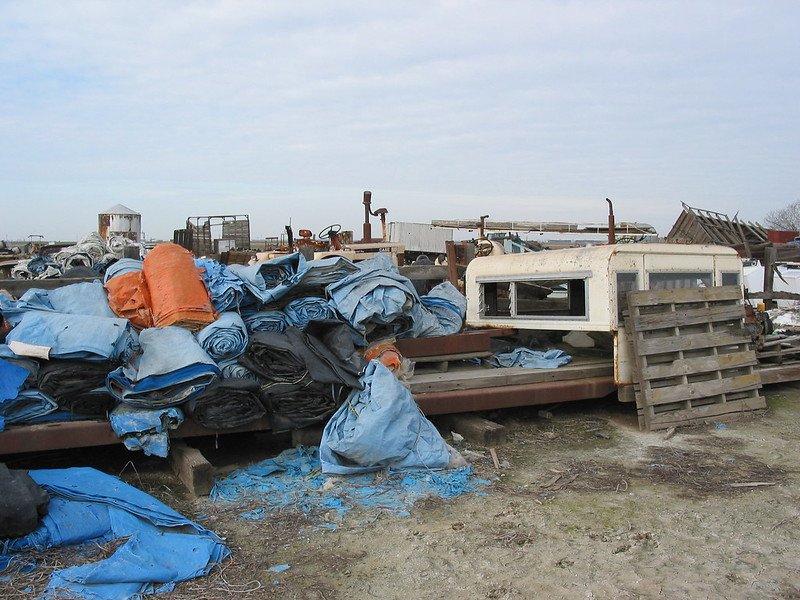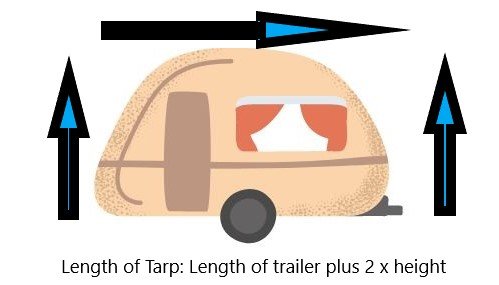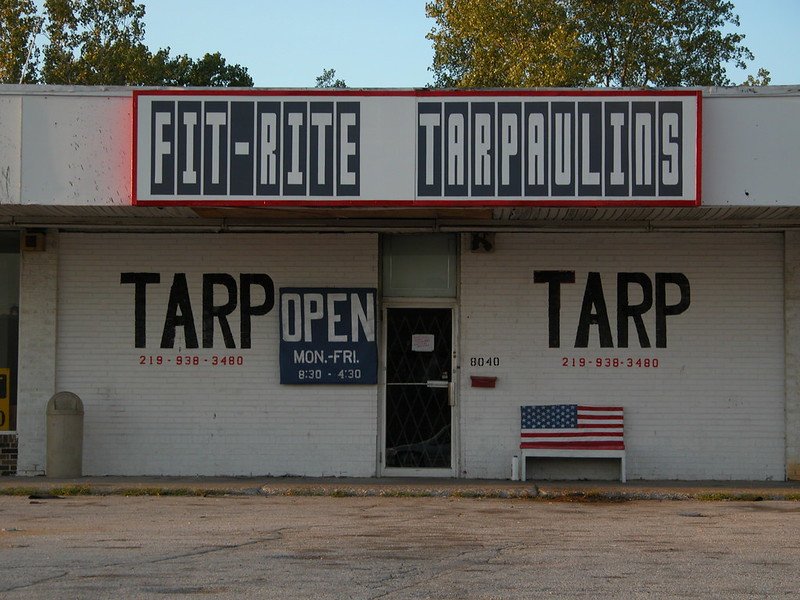By the way… any links on this page that lead to products on Amazon and other companies are affiliate links and I earn a commission if you make a purchase. Thanks in advance for your support!
Your travel trailer represents a big investment, and to preserve it you will need to think about how you’ll keep the winter weather at bay. Our approach is to use a tailored cover for our pop up camper, but many trailer owners use a simple camper tarp, so this article considers how best to tarp a trailer for winter storage, and without damaging it in the process. We did a lot of research to see what’s the best camper and RV tarp to use, and how to tarp a trailer for winter.
How to tarp a trailer for winter:
- Wash and polish the trailer first.
- Obtain a large enough tarp – measure the length of the trailer roof, plus the height of the two ends, by the width of the roof, plus the height of the two sides.
- DON’T USE A CHEAP BLUE OR GREEN TARP. Make it a good quality tarp – breathable, multi layered tarps are best. Ensure the tarp has strong, rust proof grommets at regular intervals.
- If your trailer is large, get some help.
- Ideally try and avoid covering your trailer in inclement weather.
- Start by folding the tarp into quarters and placing on the trailer roof, then unfold each side in turn, so tarp covers the roof and sides.
- If possible, gather tarp around the door, so that there is sufficient material to allow access if necessary.
- Cover any protrusions, such as gutter pipes and flues, with foam pipe.
- Secure tarp with bungees and ratchet straps so it doesn’t flap, making sure the bungees do not rub the paintwork.
- Finally, position the trailer inclined.
For more detail, keep on reading, or jump to the bits which particularly interest you…
- Should I Cover My Travel Trailer For Winter?
- What Type of Tarp Should I Use To Cover My Trailer?
- What Tarp Thickness Should I Use?
- How To Tarp a Trailer For Winter
- Wash The Trailer
- Buy a Big Enough Tarp
- Use a Good Quality Tarp – DON’T Do This!
- If Your Trailer is Large, Get Some Help
- Try and Avoid covering Your Trailer In Inclement Weather
- A Technique for More Easily Covering Your Trailer
- Allow Sufficient Slack In The Tarp To Allow Access If Necessary
- Cover Protrusions With Foam Pipe Insulation
- Secure Tarp with Bungees and Ratchet Straps
- Position The Trailer Inclined
- And Finally…
Should I Cover My Travel Trailer For Winter?
So what are the pros and cons of covering a trailer with a tarp for the Winter season? Almost every professional who talks about covering your trailer, advises not to cover with a tarp, but rather with a tailored cover made for your make and model of trailer (actually, they do talk about putting your trailer under a hard cover or in a barn or garage in ideal circumstances – but hey, who has those?).
But tailored covers can be expensive, so if you’re careful, tarps can offer a good degree of protection. You could even use a RV roof cover tarp, rather than a full tarp. What are the pros and cons of a trailer or caravan tarp?
Pros
- Keeps the trailer’s paintwork clean.
- Protects the skin of your trailer or RV from deleterious stuff such as bird droppings (which can be very acidic and damaging), tree sap and leaf mould. Better still, tarping a trailer for winter could stop damage from hail and frost. In areas of strong sunshine, a good quality tarp will protect from harmful UV rays. But make sure the inner lining of the tarp is soft.
- It will discourage vermin if secured well. (Though little furry things may still get into the trailer from openings under the trailer – make sure drain holes and such like are plugged).
Cons
- It could scratch the paintwork if a cheap tarp is used, or it’s not tied down securely.
- Moisture could be trapped between the tarp and the skin of the trailer, as a result of either rain penetration, or condensation (where moisture either gets through the tarp, or comes up from the ground below the trailer), so it’s important to use a breathable fabric. It’s always best to use a dehumidifier in the trailer, whichever type of cover you use.
- Cheap tarps break down and leak – blue tarps are often pretty cheap, but it’s best not to scrimp on cost (and therefore quality) as it will not only wear out more quickly, but it may damage your trailer. Cheap tarps are also more prone to Ultra Violet Light breakdown after a few years in the sun. Make sure you buy one which has been treated to resist UV radiation.
- Cheap tarps have cheap grommets. This could be a weak spot in the tarp, where windy conditions will put extra stress on the tarp around the grommet, and possibly result in tears. They may also rust, and stain / scratch your trailer.
- They won’t have a zipped opening for the door, so getting into your trailer once it’s tarped could be tricky, and inconvenient.
What Type of Tarp Should I Use To Cover My Trailer?

There are various tarps available, not all of which are suitable to use as covers for your trailer.
In the past canvas was used, but not so much now. Most importantly, canvas tarps are not water proof, only water resistant and they may also be prone to mildew. On the plus side, canvas covers are breathable.
The most common material used for tarps is a laminate of woven polyethylene strips and polyethylene sheets (bonded to the surface). With this combination, a poly tarp will not easily stretch or tear.
To enable them to last longer in the sun poly tarps are also treated against ultraviolet rays.
When exposed to freezing conditions, these tarp covers can still bend and flex, unlike canvas ones.
Poly tarps are also waterproof, so the item covered will stay dry under snowy and rainy conditions.
The hotter the local weather, the shorter time the tarp will last. Hotter areas like Arizona, Florida, Southern California, and Texas can expect a shorter life span. Cheap tarps will last 3 to 5 years, but they may start to leak before it shows obvious signs of wear. better quality ones could last a lot longer, maybe 10 years or more.
What Tarp Thickness Should I Use?
Tarps you buy in DIY stores are often graded according to their thickness, which is usually described as regular duty, super duty, or super heavy duty.
The regular duty are around 6 millimetres thick – which is the usual thickness of the blue tarps you can see everywhere. Super heavy duty can be up to 12 millimetres thick. We would advise going for as thick a tarp as you can afford.
How To Tarp a Trailer For Winter
Wash The Trailer
This may seem obvious, but before you tarp your trailer you should make sure the surface is clean and free of grit and grime. This will reduce the chances of any chafing between the cover and the trailer paintwork and brightwork.
Even better, put some liquid polish in the water to give the surface a protective film.
Ideally wash your trailer on a warmish day with a breeze – this will help to dry it off before being covered.
Buy a Big Enough Tarp
You could simply cover the roof of your trailer; this will help to repel water from the roof seams and keep the inside dry. However, this won’t help to protect the sides from the weather elements, and unless your trailer is huge, you should be able to get a tarp to cover the top and sides.
To check on what size you’ll need, measure the length of your trailer, then add twice the height – this will give you the length of the tarp required. Then measure the width of your trailer, and add twice the height – this will give you the required width. Here’s the length illustrated:

Use a Good Quality Tarp – DON’T Do This!
We’ve seen using a cheap tarp would be false economy – you will most likely have to replace it more often, and it won’t offer as much protection.
A large, heavy duty tarp which is currently an Amazon Best Seller, and has good reviews, can be viewed here. This is sufficient to cover a 25 ft trailer.
If Your Trailer is Large, Get Some Help
A large trailer will require a large tarp to cover it, and the weight of the heavy and super heavy tarps can be anywhere upwards of 20 pounds. This might be challenging when you’re trying to unfold the tarp at height.
Also, in windy conditions it’s always useful to have someone holding the other end as you try and secure it, which brings me on to…
Try and Avoid covering Your Trailer In Inclement Weather
Another apparent obvious one, but one which is easy to ignore. The problems with this are that it not only is more difficult to achieve a secure fit and tie down, but also you may trap water under the cover which, with a poly tarp, will take a while to disperse.
A Technique for More Easily Covering Your Trailer
If you have a big trailer or RV, a trick to make it easier to cover it with a tarp involves folding it into quarters and placing on the trailer roof, then unfold each side in turn, so the tarp covers the roof and sides.
Here’s a short video clip showing how this is done to cover the roof of a trailer, but the technique is similar to cover the whole lot. (Video credit: The Original Mechanic.) Note how he’s used a plank to keep the tarp from blowing away while he’s rolling it out.
Allow Sufficient Slack In The Tarp To Allow Access If Necessary
You never know when you might want to access the trailer during the winter months (forgot to get the peanut butter out of the cupboard?). If you have sufficient slack, gather it around the door – without making it slack so that it flaps – so you can get access.
Cover Protrusions With Foam Pipe Insulation
Anything which is sticking out proud from the skin of the trailer, such as flues, aerials, light clusters and vents, will rub against the tarp once covered. To prevent damage to those and to the tarp, it’s an idea to cover them in foam. The simplest, and cheapest, way is to buy foam pipe lagging, such as this found on Amazon:
Secure Tarp with Bungees and Ratchet Straps
As you can see in the video clip above, you can use a combination of bungees, ratchet straps and rope to secure the tarp. One little tip is to take pictures of how you secure it successfully, as sure are eggs are eggs, you’ll forget the next time you come to cover it.
Position The Trailer Inclined
Use the trailer legs to incline it slightly, so that the pooling of water on the tarp becomes less likely. This will reduce the chances of the water seeping through the seams, and even the fabric, of the tarp.
And Finally…

There is a body of opinion which thinks a trailer or RV should not be covered in the Winter, and it is certainly highly debatable (check out our article on protecting your car from snow without a garage here). However, a tarp is a relatively cheap solution to protecting your trailer from the Winter weather, but be careful – and do it properly, with a good quality tarp, and observe some simple rules set out above on how to tarp a trailer for Winter, and it will pay off when you eventually uncover your pride and joy in the Spring.


